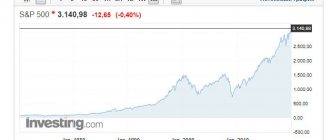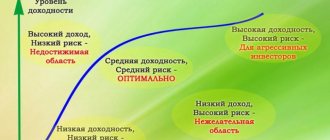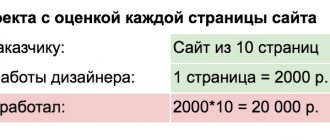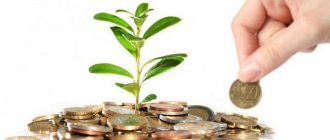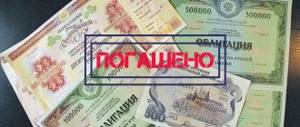olegas Jun 21, 2021 / 123 Views
It's no secret that the main goal of investing in securities is to obtain the maximum possible profit while maintaining an acceptable level of risk. In this article, I will tell you what types of securities have potentially greater profitability potential. You will learn about what their profitability consists of and how it is calculated. Finally, we will talk in detail about how you can make a preliminary assessment and calculate the expected return of securities at the stage of their selection.
- Profitability assessment based on mathematical expectation
- Profitability estimation based on historical data
What is the risk and return of securities?
Profitability is the level of profit that an investor will receive from invested capital in relation to the size of the capital itself
This indicator is usually calculated as a percentage, and for low-risk investments as an annual percentage, and for high-risk investments as a percentage per month.
Risks are considered to be different probabilities of not achieving the planned result, the most serious of which is the probability of loss of capital
This indicator is also measured as a percentage and is never equal to zero (risks always exist).
Risk and return are something that every person must evaluate when deciding to invest money in something. This applies equally to both the purchase of exchange-traded assets and the opening of a bank deposit.
You may also be interested in: How to take your first steps on the stock exchange?
Summary
For today, that’s all I wanted to tell you about, dear subscribers and visitors of my blog. My diversified portfolio is featured in the weekly reports. It consists entirely of shares of American companies and is constantly changing: some shares are sold, others are bought. Check it out and ask your questions in the comments, and I will definitely answer them. Subscribe to my blog, it's really interesting!
If you find an error in the text, please select a piece of text and press Ctrl+Enter. Thanks for helping my blog get better!
Asset risk categories
According to the degree of risk, all assets can be divided into three classes:
Low-risk instruments
This category includes debt securities (corporate and government bonds, deposits, bills).
Government securities are the most reliable; bank deposits are given weight by the fact of supervision and guarantees of deposits from the state
Another type of asset in this class is corporate securities. Since their quotes depend both on the success of the business itself and on the political and economic risks of the state.
Medium risk instruments
The category of assets with a medium degree of risk includes equity securities (shares). Here, profitability can consist of interest payments and possible growth in the value of the asset. Returns on stocks may exceed returns on bonds, but the risks of investing also increase.
High risk instruments
This primarily includes derivative (or secondary) financial instruments. There is no guaranteed return on such assets. Moreover, investors often suffer losses on these securities. But the potential profitability when working with derivative instruments is higher.
In Russia, derivatives are traded on the Moscow Exchange derivatives market (FORTS).
Calculation formula
Let's assume that on January 1, 2021, the investor had 100,000 rubles. During the year, he invested in various trading instruments, closed transactions, recording local profits and losses on them. As of December 31, 2021, his deposit amounted to 134,000 rubles. The profitability of our lucky player is calculated as follows: (134,000 – 100,000)/100,000 = 0.34, or 34 percent per annum!
If on December 31, part of his funds is “in papers,” that is, he bought, but did not sell at the end of the reporting period, then the profitability can be calculated taking into account the current market prices of these instruments.
Creating a securities portfolio
The return and risk of securities are the main concern of the investor. The point of creating a portfolio of assets is to try to achieve the required level of return while trying to reduce risk.
An investment portfolio includes a number of securities and can be owned by an individual, a company or several people/organizations on an equity basis
The assets in the portfolio can be of the same type (for example, only stocks) or very different (stocks, bonds, futures, options, real estate, precious metals).
What are the types of income from bonds?
The yield of a bond is the sum of the coupon payments that the holder receives, adjusted for various parameters.
Depending on how exactly such an adjustment is made, there are several types of bond profitability.
Coupon
The coupon yield is essentially the value of the bond's coupon.
To calculate this type of bond yield, you need to substitute the appropriate values into the formula:
Coupon Yield = coupon value * 365 / coupon duration / par value.
Important! After the calculation, you will get a fractional number in fractional expression. To make it more readable, you just need to multiply by 100, then you will get a percentage value indicating the coupon profitability.
Simple
Simple yield of bonds (Simpl Yield) = (coupon yield + full sale price – full purchase price) / full purchase price / security holding period in years.
Current
Current bond yield (Current Yield) is used when such investments of funds are considered only over a short period of time. It shows the ratio of the coupon of obligatory securities to its market price, current at the time of calculations.
Current yield = annual coupon / (cost * par-price) * 100%
or
Current yield = annual coupon / market price * 100%.
In the formula used to calculate current profitability, the concept of “market price” refers to the absolute value expressed in money (currency), and the concept of “price” refers to its percentage.
Modified
The current modified yield is an indicator that reflects the ratio of the annual coupon to the so-called dirty price of the bond, which includes the accrued coupon income. A formula is used to analyze short-term bond investments, that is, when finding the investment horizon within one coupon period.
Modified Current Yield = annual coupon / (market price + cash flow) = annual coupon / dirty price.
This type of profitability shows the amount of bond income, despite the fact that the price for which the securities can be sold at a particular point in time cannot be predicted in advance.
Discount
If the securities in question are not coupon, but discount, its profitability is calculated as follows:
Yield = (maturity cost - purchase cost) / purchase cost * 365 / number of days to maturity * 100%.
A discount bond differs from a coupon bond in that it is purchased at less than its face value.
Complex
If you want to calculate the compound yield of bonds that are subject to coupon reinvestment, there is no precise formula for performing such mathematical operations. One of the difficulties remains the unknown regarding the price at which this securities will be sold.
There are many ways to calculate complex type profitability, but the most used is to refer to tables of aggregator sites (Bonds.Finam, Rusbonds, smart-lab and others), to data from the Moscow Exchange or QUIK complex.
The standard has become the calculation of the YTM indicator (Yield to maturity or effective yield to maturity). In this case, the mathematical yield to maturity is calculated, which is equal to the rate at which the current value of cash flows equals the spot (real selling) value of the obligatory securities. To calculate the type of profitability under consideration, you also need to take into account a certain time period.
The yield to maturity calculation looks like this:
Ext. repayment = coupon payments / purchase price * 100.
Types of investment portfolios
The risk and return of each asset and their relationship with each other determines the overall type of investment portfolio. The asset income source divides the financial instrument into a growth portfolio and an income portfolio.
Growth Portfolio
It consists of companies' securities that are rising in price. An investor, creating such a portfolio, expects an increase in the price of the asset and the payment of dividends.
There are three types of growth portfolios:
- Aggressive growth portfolio. The purpose of purchasing such assets may be the hope of maximizing their value in the future. This usually includes securities of young but actively developing companies. The risk here may be high, but the return on assets has a chance to please.
- The following portfolio assumes conservative growth. Usually it includes securities of large companies - the so-called “blue chips”. There may not be high profits in a short time. However, this method of investing is deservedly considered low-risk, its composition often does not change for a long time, and the goal is, first of all, to preserve the invested funds.
- Finally, a definite middle ground and the most popular type of investment vehicle is the mid-growth portfolio. It combines the properties of the two above, since it combines both high-risk assets and reliable securities. Such a connection is designed to ensure average rates of capital growth with average investment risks.
Income Portfolio
Such a portfolio is created with the aim of providing a good current income and receiving interest and dividend payments.
Income portfolios can be of two types:
- with regular income, for which purpose it includes the most reliable securities that bring a fairly average income, but promise the smallest risks.
- a portfolio made up of income-generating securities, which include high-yield corporate bonds and high-yield, medium-risk assets.
At the same time, both the growth portfolio and the income portfolio have the same goal - to protect investments and, if possible, avoid losses that may arise both as a result of a decrease in market value and as a result of a decrease in interest payments.
Therefore, an investor should regularly assess the state of the market and the composition of the portfolio in order to timely replace assets that bring low returns or are unprofitable with high-yield securities.
All investors are faced with the need to calculate the average return of their portfolio. This is necessary in order to predict its future value. Without such a forecast, it is impossible, for example, to decide how much to replenish the investment portfolio in order to achieve the set goals on time.
Often investors make mistakes in their calculations because they use the wrong formula. Using an erroneous estimate to plan future actions is dangerous. The price of a miscalculation may be the quality of life in old age or the education of a child.
How to correctly estimate the average return
The average return of a portfolio in a given period should be considered not as an arithmetic mean, but as a geometric mean. Let's look at a simple example.
Let's say an investor invests money in Russian stocks through fund A and Russian bonds through fund B in proportions of 60 to 40. The table below shows data on the annual dynamics of the value of stocks, bonds and the total portfolio.
Table No. 1. Profitability of funds A, B and portfolio 60/40 for 4 years (in rubles).
| Tool | 2016 | 2017 | 2018 | 2019 |
| Fund A | 28,67% | -2,22% | 16,74% | 37,44% |
| Fund B | 15,24% | 14,83% | 2,7% | 15,34% |
| Portfolio 60/40 | 23,30% | 4,60% | 11,12% | 28,60% |
Source: Bloomberg, FinEx calculations
Stocks, bonds and portfolio have returned 101.86%, 56.74% and 83.81% over the entire period. At first glance, it turns out to be 20.16%, 12% and 16.9% on average for the year. In fact, these numbers are overestimated. How did this happen? The fact is that the arithmetic average (the sum of returns divided by the number of periods) is not suitable for calculating investment results, since the return obtained in the next period relates to the value of the portfolio in the previous period, and includes the return on the return of the previous period, and not only for the amount of investment. For example, if a portfolio fell by 5% over a period from the level of 10,000, and then rose by 5%, it will not return to 10,000, but will be worth RUB 9,975. In this example, the difference is small, but the greater the market volatility, the greater the discrepancy will be. - this is clearly seen in the example of fund A, which is more volatile than fund B.
In order to correctly take into account the volatility of returns and their impact on the result, the geometric mean or, as it is also called, the annualized return (Compound Average Growth Rate) is used. It is calculated as the nth root of the product of returns for n periods. For example, ∜(1.232 * 1.046 * 1.1112 * 1.286) would give an average portfolio return of 16.5% per year (not 16.7% as the arithmetic average). Like the arithmetic mean, the geometric mean does not always correspond to the indicator in any given year, but at the end of the period it transforms the initially invested amount into the exact final investment result. As a result, it is this indicator, and not the arithmetic average return, that should be used for long-term investment planning. A comparison of the dynamics of arithmetic average and real returns is presented in table No. 2 and graph No. 1.
Schedule No. 1. Dynamics of the arithmetic average and real value of the portfolio (in rubles).
Table No. 2. Dynamics of the arithmetic average and real value of the portfolio (in rubles).
Source: Bloomberg, FinEx calculations
What is the volatility bandwagon?
The difference between the arithmetic mean and geometric mean returns is called “volatility drag” or “volatility bandwagon” in academic circles. Why are we talking about the “bandwagon”? Because from a mathematical point of view, the more volatile the series of returns, the more the geometric returns will lag behind the arithmetic ones.
Volatility Drag = arithmetic mean return - geometric mean return
Despite its simplicity, this formula allows one to draw a number of interesting conclusions - for example, regarding the dangers of investments using borrowed funds ("financial leverage"), which are popular among many investors. When an investor risks not only his own money, but also borrows additional money from his broker in order to increase the size of his portfolio, he also increases its volatility.
For example, the use of leverage 2 (for each invested own ruble of investment, the investor receives another ruble on credit and invests it in the market) doubles the arithmetic return (without taking into account the costs associated with the use of leverage). But in case of a fall, the losses double. As a result, geometric average returns move more slowly due to the burden of volatility.
How does diversification affect portfolio volatility?
Portfolio diversification reduces volatility drag and therefore has a positive effect on portfolio profitability. Let's consider a simple example: an investor can invest in shares of company A or in shares of companies A and B. The volatility of shares of company A is 26%, B - 11%, their annual returns and investment results for the first and second cases are presented in the table below. As can be seen from the table, due to the greater volatility of the first instrument, even large nominal returns ultimately yield worse results than in the case of investing in different instruments, even if with a lower total return. This happens precisely because volatility eats up a lot of profitability. In the second case, the portfolio falls less than when investing exclusively in A shares, and even a small return gives a better final result of 6.7% over 10 years.
Schedule No. 2. Dynamics of a portfolio of only shares of company A and a portfolio of shares of companies A and B in a 50/50 ratio (in rubles).
Source: Bloomberg, FinEx calculations
Table No. 3. Dynamics of a portfolio of only shares of company A and a portfolio of shares of companies A and B in a 50/50 ratio (in rubles).
Source: Bloomberg, FinEx calculations
How to regulate portfolio risk and return
An investor needs to remember the golden rule of diversification. It is important that there are several securities, and each one occupies a significant, but not dominant part of the portfolio. In this case, if one of the assets begins to sharply fall in price, the remaining securities will be able to maintain the overall profitability and compensate for losses.
Diversification reduces risks, as a result of which profitability remains smooth. In addition, an investor can always get rid of an asset that has ceased to bring him the desired income and acquire a more promising one.
There is always risk, but by learning to manage it - including by creating a balanced portfolio of securities - even during periods of crisis, you can preserve and increase your capital.
Determination of profitability
Portfolios of newcomers to investment entrepreneurship usually consist of the same type of assets, which is impractical, inconvenient, and incorrect. Why is this wrong? Because the goal of any investor, if he is an investor and not a lottery player, is to choose the best conditions with maximum returns with relatively low risks. Ask any investor whether one security can completely satisfy his or her needs. I assure you, the answer will be: no! Profit with satisfaction of all needs is guaranteed only by mixed assets.
The goal of any investor is to choose the best conditions with maximum returns with relatively low risks
Every self-respecting investor with experience, when purchasing a package of securities, conducts an analysis under the prism of several indicators:
- Financial reports of the enterprise;
- Market capitalization;
- Liquidity;
- Belonging to a separate economic segment;
- Volatility of the issuer during the trading period.
The two main characteristics of portfolio returns are
- The profitability indicator of a case at a certain point in time;
- Liquidity level for specific securities.
Profitability is determined by the following formula
RP = (W1-W0)/W0
, Where:
- RP – indicator of the profitability of the investment case in percentage;
- W1 – price of a case of investment instruments relative to the beginning of the period;
- W0 – the price of a case of investment instruments relative to the end of the period.
The period is often a year, however, there are no clear rules and recommendations for choosing a period. The investor has the right to make calculations for a month, a week or an hour. This formula allows you to determine which type of assets generated profits and which were in a state of stagnation, simply taking up space within the portfolio.
Liquidity is determined by the formula
LA = (Nbid*Nask)/(Pask/Pbid-1)^2
, Where:
- LA – liquidity of specific assets;
- Nask – total number of sales orders;
- Nbid – total number of purchase orders;
- Pbid – average purchase price of an asset;
- Pask is the average selling price of an asset.
This formula is used by investors interested in determining the average statistical volume of a particular issuer. In practical terms, the average market indicator, according to which an asset is an instrument of interest to a trader, is calculated at one million lots for 24 hours. Along with the stated criteria, the level of investment security , that is, protection from various situations in the stock markets. In fact, the risk decreases simultaneously with a decrease in profitability and an increase in the size of the investment.
